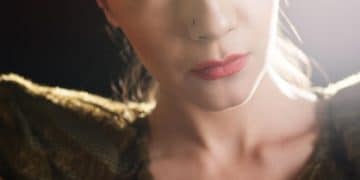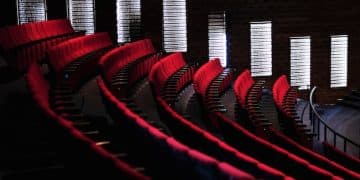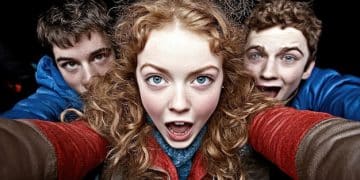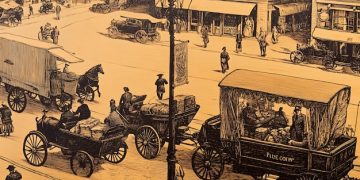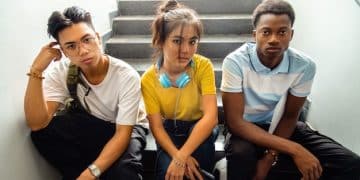Period Drama Fashion: How Costumes Inspire Modern Style in 2025

Period piece dramas significantly influence modern fashion trends in 2025 by reintroducing historical styles, fabrics, and accessories, which are then adapted and incorporated into contemporary wardrobes, reflecting a blend of nostalgia and innovation.
The allure of period piece dramas extends far beyond their captivating storylines and historical settings. One of the most fascinating aspects is their influence on modern fashion. In 2025, we continue to see period piece drama fashion trends: how costumes influence modern style in 2025, with designers and fashion enthusiasts drawing inspiration from different eras.
The Enduring Appeal of Period Drama Costumes
Period dramas have always held a special place in our hearts, transporting us to different times and places. But what is it about their costumes that continues to captivate us? Their intricate designs, luxurious fabrics, and meticulous craftsmanship offer a feast for the eyes, sparking creativity and inspiring modern fashion trends.
Historical Accuracy and Attention to Detail
One of the key reasons period drama costumes are so appealing is the dedication to historical accuracy. Costume designers meticulously research the fashion of the era they’re portraying, ensuring that every garment, accessory, and hairstyle is authentic. This attention to detail creates a sense of immersion, allowing viewers to truly step into the world of the story.
Creating Iconic Looks
Period dramas often introduce or re-introduce iconic looks that resonate with audiences. These costumes aren’t just clothes; they tell stories about the characters wearing them, their social standing, and their inner desires. Think of Elizabeth Bennet’s empire-waist dresses in “Pride and Prejudice” or the flapper dresses in “The Great Gatsby” – these outfits have become instantly recognizable and endlessly inspiring.
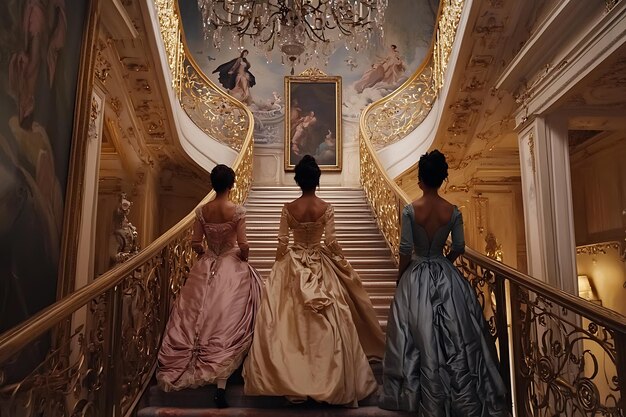
The power of these costumes lies in their ability to communicate character and context without a single word. They evoke a sense of nostalgia and romance, prompting designers and individuals to incorporate elements of these styles into contemporary fashion.
- The rise of empire-waist dresses in modern wardrobes, a nod to Regency-era fashion.
- The resurgence of vintage jewelry and accessories, inspired by the intricate pieces seen in period dramas.
- The incorporation of historical silhouettes, such as puffed sleeves and corset-inspired bodices, into modern designs.
Ultimately, the costumes in period dramas serve as a bridge between the past and the present, offering endless inspiration for modern fashion. They remind us of the beauty and craftsmanship of bygone eras, while also sparking creativity and innovation.
Key Fashion Trends Influenced by Period Dramas in 2025
In 2025, the influence of period dramas on fashion is more evident than ever. Several key trends have emerged, each drawing inspiration from different eras and styles. These trends not only reflect our fascination with history but also our desire to incorporate timeless elegance into modern wardrobes.
Regencycore: “Bridgerton”‘s Enduring Legacy
The popularity of “Bridgerton” has sparked a phenomenon known as Regencycore, which continues to influence fashion in 2025. This trend embraces the elegance and romance of the Regency era, with elements like empire-waist dresses, delicate embroidery, and pastel colors making their way into modern designs.
Victorian Gothic: A Touch of Darkness and Romance
Victorian-era dramas, with their blend of romance and darkness, have inspired a Victorian Gothic trend. This style features high-neck lace blouses, velvet dresses, and dark floral prints. The Victorian Gothic trend offers a unique and dramatic take on period fashion, appealing to those who appreciate a touch of mystery and elegance.
These trends are not just about replicating historical costumes; they are about reinterpreting them for the modern world. Designers are finding creative ways to incorporate elements of period fashion into contemporary designs, creating looks that are both timeless and on-trend.
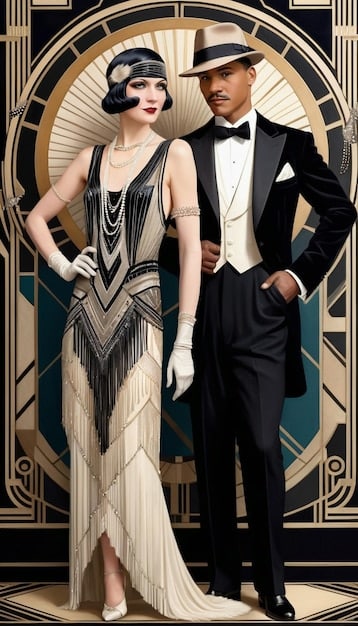
- Incorporating lace and ruffles into modern blouses and dresses.
- Using velvet and brocade fabrics in contemporary outerwear.
- Experimenting with historical silhouettes, such as corsets and bustles, in modern designs.
Fashion in 2025 is about more than just aesthetics; it’s about storytelling and self-expression. By drawing inspiration from period dramas, designers and individuals can create looks that are not only beautiful but also meaningful, reflecting a deep appreciation for history and culture.
Fabrics and Materials Making a Comeback
The fabrics and materials featured in period drama costumes often showcase a level of craftsmanship and luxury rarely seen in modern mass-produced clothing. This appreciation for quality materials has led to a resurgence in popularity for certain fabrics, with designers incorporating them into contemporary collections.
Velvet: The Epitome of Luxury and Elegance
Velvet, a staple in many period dramas, has made a strong comeback in modern fashion. Its soft texture and rich color palette make it a versatile choice for everything from dresses and skirts to blazers and accessories. Velvet adds a touch of luxury and elegance to any outfit, making it a popular choice for special occasions and everyday wear.
Brocade: Intricate Patterns and Timeless Beauty
Brocade, with its intricate woven patterns, is another fabric that has seen a resurgence in popularity. Often used in period drama costumes to showcase wealth and status, brocade is now being incorporated into modern designs for its timeless beauty and unique texture. It can be found in everything from jackets and skirts to handbags and shoes, adding a touch of sophistication to any look.
The use of high-quality materials not only elevates the aesthetic appeal of modern fashion but also reflects a growing awareness of sustainability and ethical production practices. Consumers are increasingly seeking out garments made from natural fibers and crafted with care, leading to a renewed appreciation for the fabrics and techniques used in period drama costumes.
- The use of sustainable and ethically sourced silk in modern designs.
- The incorporation of vintage lace and embroidery into contemporary garments.
- The revival of traditional weaving and dyeing techniques.
The materials used in period piece dramas are not just about aesthetics; they are about quality, sustainability, and storytelling. By embracing these fabrics, modern fashion is not only paying homage to the past but also paving the way for a more conscious and creative future.
Accessories That Define the Era and Inspire Modern Trends
Accessories play a crucial role in defining the fashion of any era, and period dramas are no exception. From delicate jewelry to elaborate headwear, accessories not only complete the look but also offer insights into the social customs and cultural values of the time. These accessories often make their way into modern fashion, adding a touch of vintage charm and sophistication.
Jewelry: From Delicate Necklaces to Statement Brooches
Jewelry is a key element in period drama costumes, often reflecting the character’s personality and social status. Delicate necklaces, pearl earrings, and statement brooches are just a few examples of the jewelry styles that have inspired modern trends. These accessories add a touch of elegance and refinement to any outfit, making them popular choices for both everyday wear and special occasions.
Headwear: Hats, Bonnets, and Hair Accessories
Headwear is another essential element of period fashion, with hats, bonnets, and hair accessories playing a significant role in defining the look of the era. From the elaborate hats of the Edwardian period to the delicate hair combs of the Victorian era, headwear adds a touch of drama and sophistication to any outfit. In 2025, we see a resurgence of these styles, with designers incorporating them into modern collections for their unique charm and elegance.
Even beyond the purely decorative elements, functional accessories featured in period dramas, such as gloves and parasols, have found new life in contemporary fashion. They add a touch of old-world charm while also serving practical purposes, underscoring the enduring appeal of well-designed accessories.
- The revival of vintage-inspired jewelry, such as pearl necklaces and Art Deco earrings.
- The incorporation of historical headwear styles into modern collections.
- The use of vintage-inspired handbags and clutches to complete an outfit.
In 2025, accessories are not just about adding the finishing touch to an outfit; they are about expressing individuality and embracing history. By drawing inspiration from period dramas, designers and individuals can create looks that are both stylish and meaningful, reflecting a deep appreciation for the past.
How Costume Designers Influence Modern Fashion Designers
Costume designers are the unsung heroes of period dramas, meticulously crafting and curating the outfits that bring characters and stories to life. Their influence extends far beyond the screen, often inspiring modern fashion designers and setting trends that resonate with audiences worldwide.
Research and Inspiration
Costume designers immerse themselves in the history, art, and culture of the era they are portraying. This deep research provides a wealth of inspiration for modern designers, who can draw upon historical sources to create innovative and contemporary collections.
Collaboration and Interpretation
Costume designers often collaborate with historians, artisans, and other experts to ensure the accuracy and authenticity of their work. This collaborative spirit can inspire modern designers to seek out new perspectives and approaches, leading to more creative and innovative designs. Moreover, modern designers often reinterpret historical costumes, adapting them for contemporary tastes and sensibilities.
The work of costume designers provides a valuable resource for modern designers, offering a glimpse into the past and inspiring new creations. By studying their work, designers can gain a deeper understanding of fashion history and develop a more informed approach to their own designs.
- Attending exhibitions and lectures on costume design.
- Studying historical fashion archives and museum collections.
- Collaborating with costume designers on contemporary projects.
The influence of costume designers on modern fashion is undeniable. Their passion for history, attention to detail, and collaborative spirit have made them valuable resources for designers around the world.
прогнозов and Beyond: Sustainable and Inclusive Period-Inspired Fashion
As we look to the future, the influence of period dramas on fashion is set to continue, with a growing emphasis on sustainability and inclusivity. Designers are finding new and creative ways to incorporate elements of period fashion into modern designs, while also prioritizing ethical production practices and catering to diverse body types and identities.
Sustainable Materials and Ethical Production
The fashion industry is increasingly focused on sustainability, with designers seeking out eco-friendly materials and ethical production practices. Period dramas can inspire this movement by showcasing the craftsmanship and longevity of vintage garments. With a focus on durability and timelessness, ethical and sustainable brands are attracting a new audience of conscientious consumers.
Inclusive Designs and Diverse Representation
Inclusivity is another key trend in modern fashion, with designers creating garments that cater to a wide range of body types, skin tones, and gender identities. Period dramas can inspire this movement by showcasing the diversity of historical fashion and challenging traditional beauty standards. This includes plus-size period-inspired fashion, as well as brands that use models from diverse ethnic backgrounds to showcase their vintage couture.
By embracing sustainability and inclusivity, the influence of period dramas on fashion can extend beyond aesthetics, contributing to a more ethical and equitable industry. This approach not only celebrates the past but also paves the way for a more conscious and sustainable future.
- Supporting sustainable and ethical fashion brands.
- Promoting body positivity and diverse representation in fashion.
- Educating oneself on the history of fashion and its cultural significance.
The future of period-inspired fashion is bright, with a growing emphasis on sustainability and inclusivity. By embracing these values, the fashion industry can create garments that are not only beautiful but also meaningful, reflecting a commitment to a better world.
| Key Aspect | Brief Description |
|---|---|
| ✨ Regencycore | Elegant dresses, pastel colors inspired by “Bridgerton”. |
| 🖤 Victorian Gothic | Lace blouses, velvet fabrics with dark floral prints. |
| 💎 Vintage Jewelry | Pearl necklaces, brooches, and Art Deco earrings. |
| 🧵 Sustainable Fabrics | Ethically-sourced silk, natural fibers, vintage materials. |
FAQ
▼
Regencycore fashion includes empire-waist dresses, delicate embroidery, and pastel colors. Think of the elegant gowns worn in “Bridgerton,” but adapted for modern wear with lighter fabrics and simpler designs.
▼
Victorian Gothic incorporates dark floral prints, velvet fabrics, and lace blouses, often in black or deep shades. It takes the romance of Victorian fashion and adds an element of mystery and drama.
▼
Vintage-inspired accessories offer a unique blend of charm and sophistication. These accessories add a touch of elegance to modern outfits, giving a nod to the past while remaining relevant.
▼
Sustainable fabrics are made from eco-friendly materials like organic cotton, recycled polyester, or ethically sourced silk. They are produced using methods that minimize environmental impact and support fair labor practices.
▼
Costume designers conduct thorough research on historical periods, inspiring modern designers. Their creative interpretations often spark new trends. They also prioritize storytelling, which resonates with fashion-conscious consumers.
Conclusion
In 2025, the influence of period drama fashion continues to captivate and inspire, blending historical elegance with modern sensibilities. By drawing inspiration from different eras, designers and fashion enthusiasts create looks that are not only stylish but also meaningful, reflecting a deep appreciation for the past and a commitment to a more sustainable and inclusive future.
